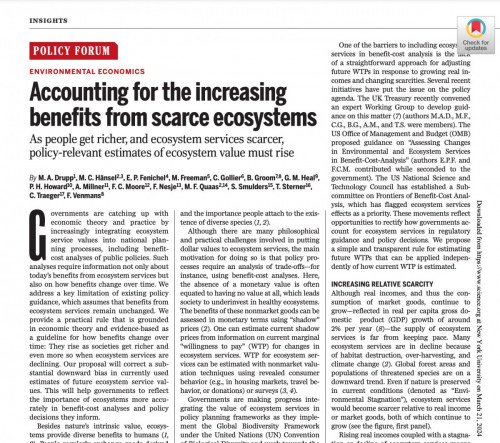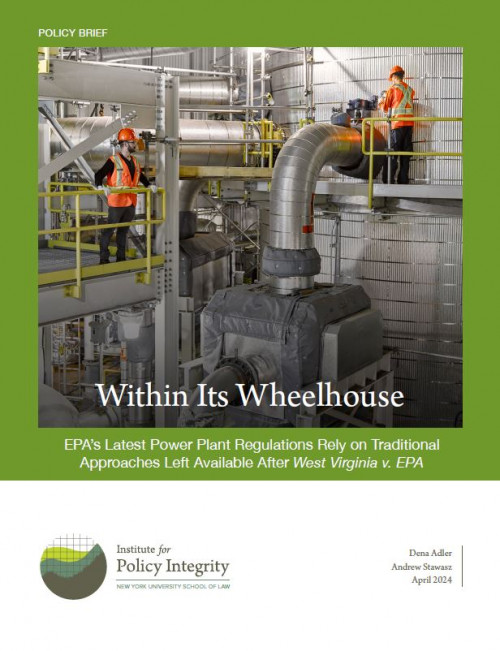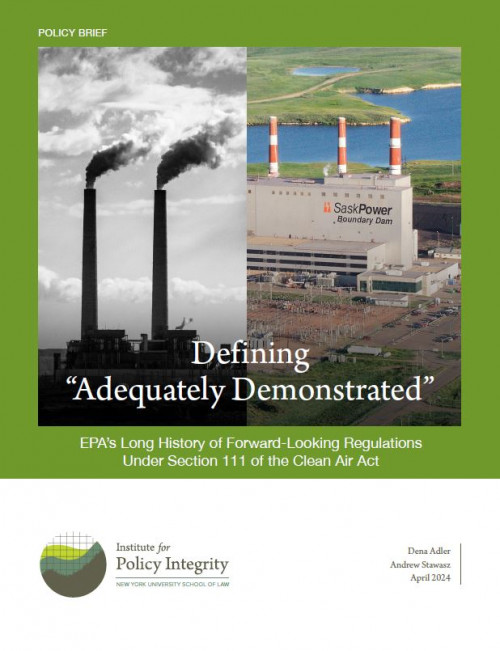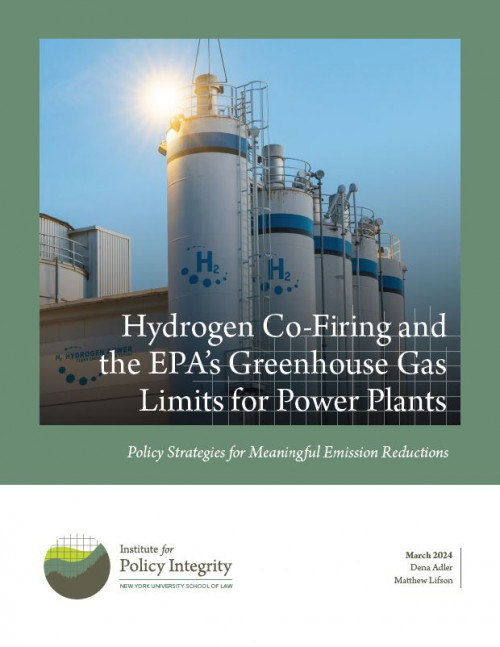-
Within Its Wheelhouse
EPA’s Latest Power Plant Regulations Rely on Traditional Approaches Left Available After West Virginia v. EPA
In May 2023, EPA proposed new limits for greenhouse gas (GHG) emissions from certain fossil-fuel-fired power plants under Section 111 of the Clean Air Act. Some critics have suggested that EPA’s new rule triggers the major questions doctrine. Under that doctrine, a court should look skeptically on the agency action in extraordinary cases involving unprecedented and transformative applications of agency authority. But the major questions doctrine is inapplicable to EPA’s use of CCS in its proposed regulations. Rather than propose a new approach that would transform its exercise of statutory authority, EPA has embraced one of its most traditional and well-established regulatory practices: setting emission limits based on pollution controls that cause a regulated source to operate more cleanly. This policy brief details why EPA’s latest proposal to limit GHG emissions from power plants fits neatly within the bounds of the legal authority left intact after West Virginia. It then explains how states and operators retain flexibility to use emission trading and averaging programs to implement EPA’s regulations.
-
Defining “Adequately Demonstrated”
EPA’s Long History of Forward-Looking Standards Under Section 111 of the Clean Air Act
In May 2023, the Environmental Protection Agency (EPA) proposed new limits for greenhouse gas (GHG) emissions from certain fossil-fuel-fired power plants under Section 111 of the Clean Air Act. Section 111 requires EPA to set limits reflecting the emission reductions achievable by applying what the agency determines to be the “best system of emission reduction” (BSER) that “has been adequately demonstrated,” and that meets certain other statutory factors. This policy brief summarizes the legal framework of Section 111 (including the legislative history and caselaw relevant to understanding its technology-forcing nature), walks through how courts have interpreted “adequately demonstrated,” reviews EPA’s past use of Section 111 to drive technology improvements, and explains why a potential Supreme Court decision that eliminates or curtails Chevron deference (a legal doctrine providing deference to reasonable agency interpretations of ambiguous statutory language) would not affect the longstanding interpretation of “adequately demonstrated.”
-
Comments to Montana PSC on Petition for Rulemaking on Consideration of Climate Impacts
In February, a coalition of public-interest organizations filed a petition for rulemaking requesting that the Montana Public Service Commission consider climate change in its regulation of electric and gas utilities. The Petition for Rulemaking calls on the Commission to consider the impacts of climate change in its proceedings using the Environmental Protection Agency’s latest estimates of the social cost of greenhouse gases. In support of the petition, we submitted comments offering a few helpful insights.
-
Hydrogen Co-Firing and the EPA’s Greenhouse Gas Limits for Power Plants
Policy Strategies for Meaningful Emission Reductions
In May 2023, EPA proposed new limits for carbon dioxide emissions from fossil fuel-fired power plants. The proposed rule reflects a decade of careful development from EPA and embraces an approach consistent with the Supreme Court’s ruling in West Virginia v. EPA. In order to follow that approach, EPA based the limits for certain natural gas-fired turbines on the emission reductions achievable through hydrogen co-firing (i.e., burning a blend of natural gas and hydrogen). Unlike fossil fuels, hydrogen does not release CO2 when burned, but producing hydrogen can cause significant greenhouse gas (GHG) emissions depending on how its produced. Given these potential emissions, it is important to consider what type of hydrogen a power plant will co-fire with—otherwise this approach to reducing emissions could exacerbate climate change. This report explains the role of hydrogen co-firing in EPA’s proposed rule, discusses how EPA should design its final rules to achieve the specified GHG-reduction goals, and highlights additional actions that EPA and other regulators can take to further minimize the emissions (and the resulting climate harm) from hydrogen co-firing.
-
Comments to EPA on Amendments to New Source Performance Standards and Emissions Guidelines for Large Municipal Waste Combustors
In January, the Environmental Protection Agency (EPA) proposed a rule that would amend new source performance standards and emissions guidelines for large municipal waste combustors. The Proposed Rule marks an important, and overdue, step in reducing harmful pollutants from municipal waste combustion. To ensure that EPA regulates in a manner that maximizes social welfare, without leaving potential net benefits on the table, the Institute for Policy Integrity submitted comments recommending that EPA conduct additional analysis. -
Letter to DOE on Programmatic Review of LNG Export Program
In January, the White House announced a pause on LNG export approvals for the Department of Energy to update its underlying analyses for authorizations, which underpin its public interest determinations. In particular, the announcement notes that DOE’s economic and environmental analyses are outdated and calls for them to be updated. This letter offers recommendations for updating DOE’s analyses.
-
Policy Integrity Recommendations Reflected in Amendments to EPA’s RMP Rule
In February 2024, EPA finalized amendments to its Risk Management Program (RMP), under Section 112(r) of the Clean Air Act, to better protect vulnerable communities from chemical disasters that release toxic air pollution. In line with Policy Integrity’s recommendations, the final rule has been strengthened relative to the proposal and includes considerably more attention to the issues of underreporting, unquantified benefits, and the risks of catastrophic incidents. EPA has further improved the final rule to include consideration of climate change-related hazards in line with Policy Integrity’s recommendation to cover climate change-exacerbated hazards in addition to climate change-caused hazards. This will be increasingly important as the risks and magnitude of future chemical incident damages will likely only grow as climate change exacerbates severe weather that can spur power outages and chemical disasters.
-
Joint Comments to New York State DEC and NYSERDA on New York Cap-and-Invest Program
The Institute for Policy Integrity submitted joint comments (along with the Guarini Center on Environmental, Energy and Land Use Law) to the New York State Department of Environmental Conservation (DEC) and the New York State Energy Research and Development Authority (NYSERDA) in response to a request for comment on various recent publications and presentations concerning the future New York Cap-and-Invest Program (NYCI). -
Comments to DOE on Proposed Efficiency Standards for Fans and Blowers
In January, the Department of Energy proposed to strengthen its energy efficiency standards for fans and blowers, which would save consumers in energy costs and reduce pollution that harms public health and exacerbates climate change. Our comment offered several suggestions to improve the rule and accompanying analysis.
-

Accounting for the Increasing Benefits From Scarce Ecosystems
As people get richer, and ecosystem services scarcer, policy-relevant estimates of ecosystem value must rise
Governments are catching up with economic theory and practice by increasingly integrating ecosystem service values into national planning processes, including benefit-cost analyses of public policies. Such analyses require information not only about today’s benefits from ecosystem services but also on how benefits change over time. We address a key limitation of existing policy guidance, which assumes that benefits from ecosystem services remain unchanged. We provide a practical rule that is grounded in economic theory and evidence-based as a guideline for how benefits change over time: They rise as societies get richer and even more so when ecosystem services are declining. Our proposal will correct a substantial downward bias in currently used estimates of future ecosystem service values.
Viewing recent projects in Climate and Energy Policy












